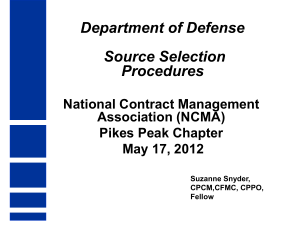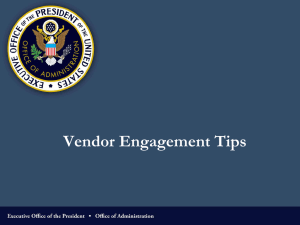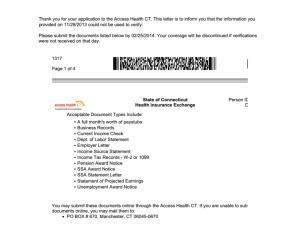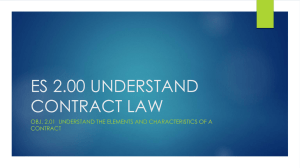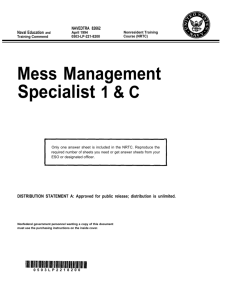2011 WOSB Presentation_Robison
advertisement
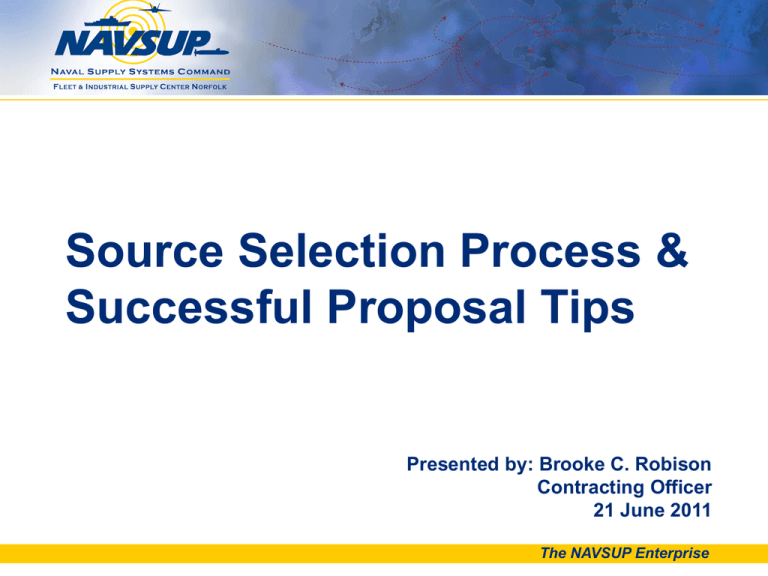
Source Selection Process & Successful Proposal Tips Presented by: Brooke C. Robison Contracting Officer 21 June 2011 The NAVSUP Enterprise Objectives Objectives of the source selection process: Ensure the impartial, equitable, and comprehensive evaluation of offerors’ proposals; Maximize the efficiency and minimize the complexity of the proposal evaluation and contractor selection process so as to minimize the cost of the process to Government and industry; Select the offeror whose proposal is the best value to the Government considering cost/price, technical factors, and past performance; Document the basis for the selection decision. References References FAR Part 15 DFAR Part 215 DPAP Memo “DoD Source Selection Procedures”, effective July 1, 2011 Methods of Selection Source selection results in two methods of selection for award of a contract: Tradeoff – Best Value – Allows for a tradeoff between non-cost factors and cost/price (FAR 15.101-1) Lowest Price, Technically Acceptable (LPTA) – used when best value is expected to result from selection of a technically acceptable proposal with the lowest evaluated price (FAR 15.101-2) Steps of the Source Selection Process 1. Designate Source Selection Official 2. Establish evaluation groups 3. Develop and approve the SSP 4. Develop, review, and issue the solicitation 5. Receive and evaluate proposals 6. Conduct discussions and request, receive, and evaluate final proposal revisions (if necessary) 7. Prepare the supporting documentation for the selection decision 8. Select the source 9. Brief the principal results of the source selection decision to appropriate officials 10. Award contract(s) 11. Debrief unsuccessful offerors 12. Report lessons learned Source Selection Plan Required for all best-value, negotiated, competitive acquisitions under FAR Part 15 The SSP shall include, at a minimum Background and Objectives Acquisition Strategy Source Selection Team Communications Evaluation Factors and Subfactors Documentation Schedule of Events Non-Government Personnel Securing Source Selection Material Source Selection Team Roles and Responsibilities Source Selection Authority (SSA) Procuring Contracting Officer (PCO) Source Selection Advisory Council (SSAC) Source Selection Evaluation Board (SSEB) Advisors Cost or Pricing Experts Legal Counsel Small Business Specialist Other Subject Matter Experts Source Selection Team Roles and Responsibilities Source Selection Authority (SSA) Appoint chairperson for SSEB and, when used, SSAC Approve the SSP Make determination to award without discussions or enter into discussions Select the source Document the source selection rationale SSA cannot be PCO for acquisitions of $100M or more Source Selection Team Roles and Responsibilities Procuring Contracting Officer (PCO) Assist SSA in execution of duties and work with SSEB Chair to ensure proper technical evaluation Serve as the single point of contact for all solicitation-related inquiries from prospective offerors Source Selection Advisory Council (SSAC) Provide written comparative analysis and recommendation to SSA Provide oversight to SSEB Source Selection Evaluation Board (SSEB) Refers to the price and technical evaluation team SSEB duties shall take priority over all other work Source Selection Plan – Evaluation Factors Cost or Price Evaluation Shall be evaluated in every source selection No adjectival ratings shall be used (cost/price not rated) Must determine reasonableness of cost/price Technical Rating Evaluation Process Degree to which the proposed technical approach meets or does not meet minimum performance Past Performance Evaluation (when required, documented by PCO) Assessment of the offeror’s probability of meeting the solicitation requirements Evaluation considers recent and relevant record of performance Small Business Evaluation (when required) Establish separate SB participation evaluation factor Establish SB participation subfactor under the technical factor, or Consider SB participation within evaluation of one of the technical subfactors Evaluation Documentation SSEB Chairperson consolidates the inputs from each of the evaluation teams for presentation to the SSA Minority views shall be documented All evaluation records and narratives shall be reviewed by the PCO, Legal Counsel, and the SSEB Chairperson for completeness and compliance with the solicitation The SSAC will consolidate the advice and recommendations from the SSAC into a written comparative analysis and recommendation for the SSA to make the best-value decision Competitive Range/Discussions The SSA may choose to award a contract on the basis of the initial proposals Award without discussions shall occur only in limited circumstances Discussions are highly recommended PCO establishes competitive range Discussions conducted through release of Evaluation Notices (ENs) Prepared by the SSEB Clearly indicate the type of exchange being conducted (e.g. clarification, communication, etc) Any EN addressing a proposal deficiency or weakness shall clearly indicate that a deficiency/weakness exists The PCO shall obtain the SSA’s concurrence prior to releasing the FPR request Source Selection Process If an SSAC is utilized, the SSAC shall review the evaluation and findings of the SSEB to ensure accuracy, consistency, and supportability IAW the evaluation criteria SSAC shall provide a written comparative analysis of proposals and award recommendation for the SSA’s consideration If an SSAC is not utilized, the SSEB should not conduct a comparative analysis of the proposals or make an award recommendation unless specifically requested by the SSA or required by the SSP Source selection decision shall represent the SSA's independent judgment and the SSA shall document the supporting rationale Successful Proposal Tips Presented by: Brooke C. Robison Contracting Officer 21 June 2011 The NAVSUP Enterprise Proposal Tips Review the ENTIRE Request for Proposal I -The Schedule: A –H A: Solicitation/Contract Form B: Supplies or services and prices/costs C: Description/specifications/statement of work D: Packaging and marking E: Inspection and acceptance F: Deliveries or performance G: Contract Administration Data H: Special contract requirements II -Contract Clauses: I III -List of Documents, Exhibits & Other Attachments: J IV -Representations and Instructions: K, L & M Proposal Tips Follow the Instructions!! Proposal must be submitted on time and in the correct medium Proposal must include all the requested information Proposal should not contain extraneous information Proposal must be complete, whereas “fill-ins” representations, certifications, matrices are complete, especially in identifying Government Rights to Technical Data (DFAR 252.227-7017) Questions asked relatively close to the proposal due date run the risk of answers not being provided before the closing time Proposal Tips What is the Government asking you to provide? Technical Recognize and understand the factors and weightings, Preliminary Evaluations and/or Pass/Fail criteria Discuss product/service in sufficient detail to demonstrate compliance with the Government’s requirement Technical approach and pricing proposal should be consistent Sufficiently provide the required information and provide accurate data Cost/Price Provide the supporting documentation for pricing (Commercial Price List, pricing anomalies, inflation, escalation, CDRLs, discount terms, etc.) Rates must be compliant with DCAA (if applicable) Past Performance Provide the supporting documentation for past performance Follow the instructions and understand the requirements Proposal Tips Offeror must keep abreast of amendments to the solicitation Changes in the specification, proposal instructions, evaluation criteria, proposal due date Don’t assume anything, if questionable, put in writing your concern to the Contracting Officer or Contract Specialist Ensure you have met all of the minimum requirements of the RFP Always put your best proposal together; there may not be any rounds of discussions Proposal Tips REMEMBER: SECTION L or FAR 52.212-1 SECTION M or FAR 52.212-2 Instructions to Offerors Identifies for offerors what they are required to submit Evaluation Criteria Identifies to offerors how the Government is going to evaluate what we have asked offerors to submit Basis for Award Proposal Tips When there is a conflict between the SSP and the RFQ/RFP….GAO will differ to the terms of the solicitation An agency shall evaluate competitive proposals and then assess their relative qualities solely on the factors and subfactors specified in the solicitation QUESTIONS? The NAVSUP Enterprise BACK-UP SLIDES The NAVSUP Enterprise Evaluation Process Combined Technical and Risk Table 1. Combined Technical/Risk Ratings Color Rating Description Blue Outstanding Proposal meets requirements and indicates an exceptional approach and understanding of the requirements. Strengths far outweigh any weaknesses. Risk of unsuccessful performance is very low. Purple Good Proposal meets requirements and indicates a thorough approach and understanding of the requirements. Proposal contains strengths which outweigh any weaknesses. Risk of unsuccessful performance is low. Green Acceptable Proposal meets requirements and indicates an adequate approach and understanding of the requirements. Strengths and weaknesses are offsetting or will have little or no impact on contract performance. Risk of unsuccessful performance is no worse than moderate. Yellow Marginal Proposal does not clearly meet requirements and has not demonstrated an adequate approach and understanding of the requirements. The proposal has one or more weaknesses which are not offset by strengths. Risk of unsuccessful performance is high. Red Unacceptable Proposal does not meet requirements and contains one or more deficiencies. Proposal is unawardable. The NAVSUP Enterprise Evaluation Process Past Performance (Relevancy) Table 4. Past Performance relevancy Ratings Rating Definition Very Relevant Present/past performance effort involved essentially the same scope and magnitude of effort and complexities this solicitation requires. Relevant Present/past performance effort involved similar scope and magnitude of effort and complexities this solicitation requires. Somewhat Relevant Present/past performance effort involved some of the scope and magnitude of effort and complexities this solicitation requires. Not Relevant Present/past performance effort involved little or none of the scope and magnitude of effort and complexities this solicitation requires. The NAVSUP Enterprise Evaluation Process Past Performance (Confidence) Table 5. Performance Confidence Assessments Rating Description Substantial Confidence Based on the offeror’s recent/relevant performance record, the Government has a high expectation that the offeror will successfully perform the required effort. Satisfactory Confidence Based on the offeror’s recent/relevant performance record, the Government has a reasonable expectation that the offeror will successfully perform the required effort. Limited Confidence Based on the offeror’s recent/relevant performance record, the Government has a low expectation that the offeror will successfully perform the required effort. No confidence Based on the offeror’s recent/relevant performance record, the Government has no expectation that the offeror will be able to successfully perform the required effort. Unknown Confidence (Neutral) No recent/relevant performance record is available or the offeror’s performance record is so sparse that no meaningful confidence assessment rating can be reasonably assigned. The NAVSUP Enterprise Evaluation Process Small Business Ratings dependent on the small business evaluation methodology utilized When evaluating small business participation as a standalone evaluation factor or a subfactor under the technical factor, there are two rating options Use the ratings acceptable and unacceptable only (i.e., pass/fail), or Use all ratings outlined in the tables on the previous slides,. When small business participation is not evaluated as a stand-alone evaluation factor or subfactor but instead is considered within the evaluation of one of the technical subfactors, a separate small business rating is not applied The NAVSUP Enterprise

